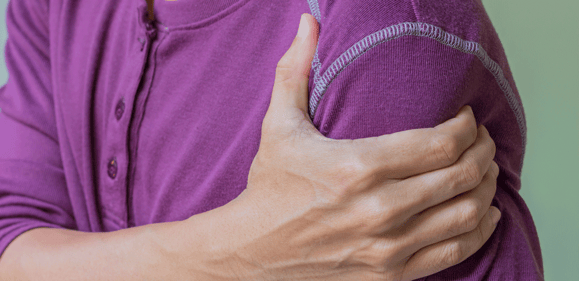Shoulder injuries happen easier than you might think and they can be painful!
From everyday activities like picking up your grandchild for a big hug or occasional, more physically-straining activities like chopping wood, they can affect anybody.

Why is it so easy to injure and difficult to heal? Two bones, and a complex array of muscles and ligaments make up the shoulder areas. While generally robust parts of the body, your shoulders are susceptible to injury, inflammation or degeneration of tissue due to aging.
Athletes participating in contact sports are more prone to shoulder injuries. Tears and separations are especially painful. However, older adults who suffer from arthritis or falls can also endure equally agonizing shoulder issues.
The good news is that there are ways to reduce the possibility for injuries and ease the pain.
Strains
Younger people and athletes are more prone to strains because their bodies are still growing and adjusting. They are participating in competitive activities like throwing balls, tackling, and using their shoulders for blocking. They’re pushing their muscles and ligaments beyond their limits, making them more prone to soreness and inflammation.
These kind of injuries, however, aren’t limited to the young. “Weekend Warriors,” older people who do most of their movement on weekends or after work, sometimes also go beyond capacity with too much activity all at once.
Rest and ice takes care of most strains. Physical therapy might be in order to restore flexibility.
Dislocation
Dislocation occurs when two bones and the joint areas are suddenly moved out of alignment due to an accident or hard contact. The ligaments no longer hold the bones together, which means you need immediate attention by a doctor.
For the shoulder to heal properly, the healthcare provider must move the bones and surrounding tissue “back into place” by gently pulling on it.
Once reset, apply ice to the injured area to help reduce swelling. Most importantly, give your shoulder time to heal by resting and avoiding intense activity.
Tears
Four muscles are connected to the bones by tendons, which are often called the Rotator Cuff area. Sometimes these tendons are torn by repetitive motion (typically overhead motions), extreme pressure or a fall. This may include regular activities like:
- Pitching in baseball
- Swinging in tennis
- Lifting a heavy object
If you have a tear, you’ll feel tenderness in the shoulder and may have trouble lifting your arm. You also might feel pressure or pain when touched on the shoulder or laying down.
Rest, ice, compression and elevation helps it heal. Physical therapy exercises may also help improve flexibility and strength in Rotator Cuff area. With more extensive injuries surgery might be necessary to reattach the tendons.
Frozen Shoulder
For people with certain medical conditions, healing after a minor shoulder injury is more difficult. Scar tissue builds up in the shoulder, which reduces flexibility and makes it painful and almost immobile. This happens most often to adults between 40 and 60 years old, especially those who suffer from diabetes, thyroid, or heart disease.
Usually, physical therapy, ibuprofen and steroid injections help patients recover and reduce the pain.
Arthritis
Generally caused by overuse and age, the shoulder can be susceptible to osteoarthritis. The cartilage that lines the bones of the shoulder are worn out and the joints become inflamed.
Rest, medication and cortisone shots are helpful. In some cases, surgery is needed to replace the shoulder joint.
As a general rule, rest is the best medicine at the first sign of shoulder pain. You may also consider physical therapy exercises to help weakened areas. Consult your primary care physician or the Johnson Memorial Orthopedic and Sports Medicine Specialists if the pain persists and disrupts your quality of life.
